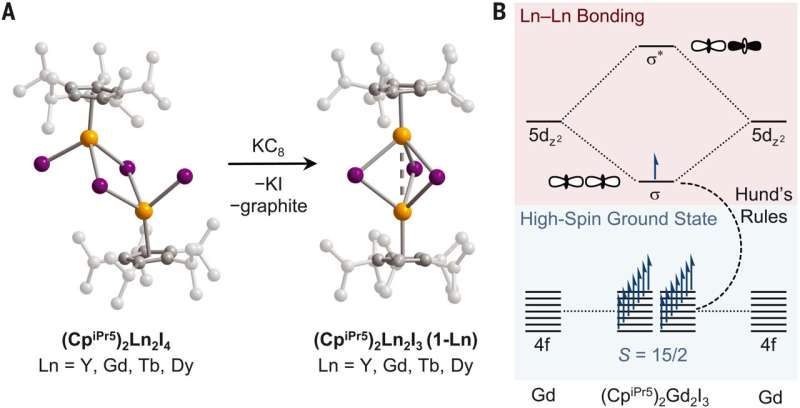Credit: DOI: 10.1126/science.abl5470
A team of researchers affiliated with a large number of institutions in the U.S. reports a way to use lanthanide–lanthanide bonds to create more powerful permanent magnets. In their paper published in the journal Science, the group describes a technique to forge several kinds of lanthanide bonds for use in magnets. Lanthanides are the 15 metallic chemical elements numbered 57 to71.
As the researchers note, large valance orbitals that allow for overlapping are generally needed to create metal-to-metal bonding. For that reason, lanthanide-to-lanthanide bonds have not been considered as a possible source for building magnets. In this new effort, the researchers have uncovered di-lanthanide complexes that overcome that problem in a big way.
The researchers found a class of divalent lanthanide ions that were symmetrically compatible with 5d orbitals. Using them, they were able to establish dysprosium–dysprosium, terbium–terbium and gadolinium–gadolinium bonds. The first two showed a strong potential for creating strong magnets. Using bonds in both of them, the researchers created complexes with dual metal centers that shared a d electron. In both cases, three iodine atoms were arranged in triangles around the metal centers. The metal atoms were held together by a bond that ran through the center of the triangular structure with an unpaired electron in the middle. The researchers suggest that in addition to its extreme magnetism, the bond represented the first of its kind between two rare earth materials.
The newly discovered bonds have a bonding strength of approximately 14 tesla at temperatures as high as 60K—a new record for a molecule-based material. The prior record was 7.9 tesla. The newly discovered bonds could be used to create a new class of super-strong permanent magnets. The researchers also found that the overall field strength of the materials they created was too strong to measure accurately with their equipment; thus, their numbers are estimates. They suggest magnets made using their techniques could be used both for small media storage applications and for large technical applications that require new types of solid materials.
More information: Colin A. Gould et al, Ultrahard magnetism from mixed-valence dilanthanide complexes with metal-metal bonding, Science (2022). DOI: 10.1126/science.abl5470
Journal information: Science
© 2022 Science X Network























